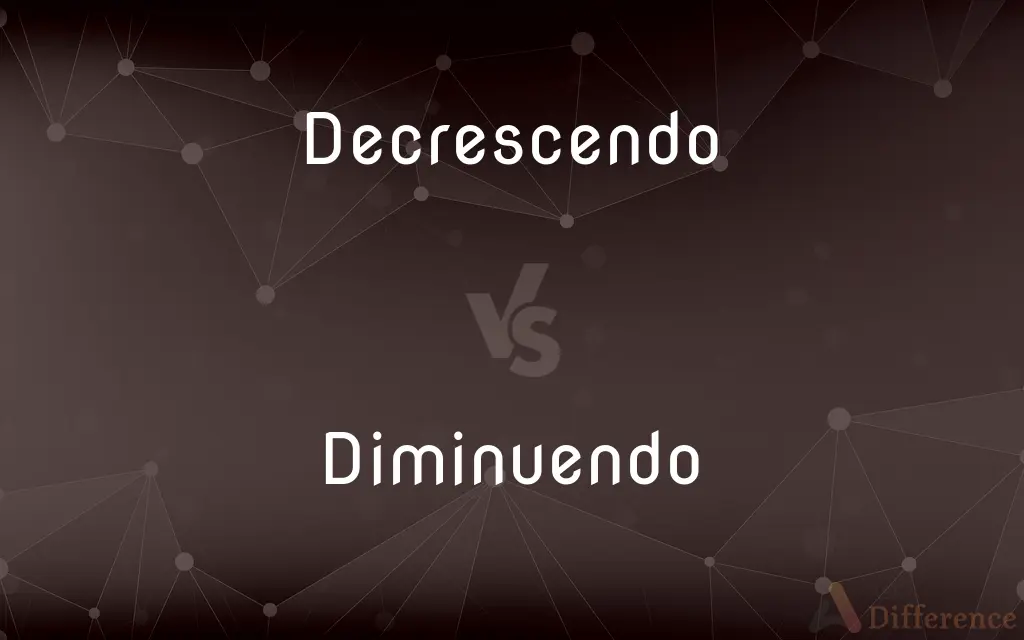Decrescendo vs. Diminuendo — What's the Difference?
By Fiza Rafique & Urooj Arif — Updated on March 27, 2024
Decrescendo refers to gradually decreasing in loudness in music, often symbolized as "decresc.," while diminuendo, marked as "dim.," also means a gradual reduction in volume but is sometimes used to imply a more subtle or extended decrease.

Difference Between Decrescendo and Diminuendo
Table of Contents
ADVERTISEMENT
Key Differences
Decrescendo is a musical term indicating a gradual decrease in volume or intensity of the music. It signals performers to lower the loudness of their playing progressively over a specified passage. On the other hand, diminuendo, although often used interchangeably with decrescendo, can carry a connotation of a more extended, subtle reduction in sound, guiding performers to gently taper their volume over possibly a longer span of music.
Decrescendo can often be found in dramatic or emphatic parts of a composition where a noticeable reduction in volume creates a specific emotional or atmospheric effect. In contrast, diminuendo might be used in more delicate sections, where the composer aims for a subtle vanishing of sound, mimicking the effect of sound disappearing into the distance.
The notation for decrescendo is often a horizontal angle bracket opening towards the right (>) placed above or below the staff, signifying the section of music over which the volume should decrease. Whereas, diminuendo is frequently notated similarly but may also be indicated simply by the abbreviation "dim." without the angle bracket, especially if the composer desires a more nuanced effect.
Composers may choose decrescendo to prompt a relatively quicker and more noticeable decrease in volume, fitting for shorter passages that require a clear contrast. Diminuendo, on the other hand, might be selected for passages where the decrease in volume is to be more gradual, extending over a larger section of the composition, to elicit a more immersive or enveloping effect.
While both terms serve to guide musicians in adjusting their volume, the choice between decrescendo and diminuendo might also reflect the composer’s stylistic preference or the particular expressive qualities sought within a piece. The interpretation of these markings can vary among performers, with some perceiving them as virtually synonymous, while others may distinguish between them based on the context and desired musical effect.
ADVERTISEMENT
Comparison Chart
Definition
A gradual decrease in loudness.
A gradual decrease in loudness, often more subtle.
Symbol
">” or "decresc."
">” or "dim."
Usage in Composition
Often used for dramatic effect in shorter passages.
Suited for subtle, extended decreases in volume.
Emotional Effect
Can create a dramatic or emphatic atmosphere.
Aims for a gentle fading or vanishing sound.
Duration
Generally shorter, more noticeable.
Can be more extended, providing a nuanced effect.
Compare with Definitions
Decrescendo
Signaling a shift towards quietness.
The decrescendo was a prelude to the storm’s calm.
Diminuendo
A command for gentle volume tapering in music.
The violin's diminuendo was emotionally stirring.
Decrescendo
Instruction for musicians to play increasingly softer.
The decrescendo led to a haunting silence.
Diminuendo
A technique for achieving a vanishing sound effect.
The choir’s diminuendo was like a dissipating cloud.
Decrescendo
A marked decrease in musical intensity.
The decrescendo added dramatic tension to the finale.
Diminuendo
Indicating a slow fade in musical dynamics.
The piece concluded with a masterful diminuendo.
Decrescendo
A gradual reduction in volume in a musical piece.
The orchestra entered a decrescendo, mirroring the setting sun.
Diminuendo
A subtle decrease in sound volume over a long passage.
The diminuendo left the audience in anticipation.
Decrescendo
The process of fading out musically.
Their voices fell in a perfect decrescendo.
Diminuendo
Reflecting a nuanced musical decrease.
The diminuendo brought an ethereal quality to the piece.
Decrescendo
A gradual decrease in force or loudness.
Diminuendo
Decrescendo.
Decrescendo
With gradually diminishing force or loudness. Used chiefly as a direction.
Diminuendo
(music) A dynamic mark directing that a passage is to be played gradually more softly
Decrescendo
A decrescendo passage.
Diminuendo
(music) A passage having this mark
Decrescendo
(music) An instruction to play gradually more softly.
Diminuendo
(metaphoric) The gradual dying away of something.
Decrescendo
(music) To gradually become quieter
Diminuendo
(music) played in this style
Decrescendo
Becoming quieter gradually.
Diminuendo
(music) describing a passage having this mark
Decrescendo
With decreasing volume of sound; - a direction to performers, either written upon the staff (abbreviated Dec., or Decresc.), or indicated by the sign.
Diminuendo
In a gradually diminishing manner; with abatement of tone; decrescendo; - expressed on the staff by Dim., or Dimin., or the sign.
Decrescendo
(music) a gradual decrease in loudness
Diminuendo
(music) a gradual decrease in loudness
Decrescendo
Grow quieter;
The music decrescendoes here
Diminuendo
Gradually decreasing in volume
Decrescendo
Gradually decreasing in volume
Common Curiosities
How is decrescendo notated in music?
Decrescendo is notated with a horizontal angle bracket opening towards the right (>) or the word "decresc.".
What is the difference between decrescendo and diminuendo?
The main difference is that diminuendo often suggests a more extended, gentle decrease in volume, whereas decrescendo is typically a more noticeable reduction over a shorter passage.
What does diminuendo mean in music?
Diminuendo refers to a gradual reduction in loudness, often more extended and subtle than decrescendo.
What is a decrescendo?
A decrescendo is a gradual decrease in the volume of the music.
How do musicians interpret decrescendo?
Musicians interpret decrescendo as a directive to progressively lower their playing volume over a specified section.
What role does diminuendo play in musical composition?
Diminuendo plays a crucial role in adding emotional depth and subtlety to musical compositions, often used to achieve a vanishing sound effect.
Are there specific instruments better suited for decrescendo?
Most instruments can effectively perform a decrescendo, but the effect is particularly noticeable on sustained-note instruments like strings and wind instruments.
How do performers execute a diminuendo?
Performers execute a diminuendo by gently tapering off their volume over the indicated passage, often over a longer span than decrescendo.
Why do composers use decrescendo?
Composers use decrescendo to create dramatic effects or to signal a clear contrast in volume within a piece.
Does the length of the decrescendo affect its impact?
Yes, the length and context of a decrescendo can significantly affect its dramatic impact and emotional effect in a piece.
Can decrescendo and diminuendo be used interchangeably?
While they can be used interchangeably, nuances in their application suggest differences in the extent and subtlety of the volume decrease.
Is diminuendo the same as fading out?
Diminuendo is similar to fading out, but it is specifically used in musical contexts to describe a gradual decrease in volume.
What effect does a diminuendo have on music?
Diminuendo can add a subtle, immersive quality to music, often used to evoke the feeling of sound gently fading away.
Can electronic music incorporate diminuendo?
Yes, electronic music can incorporate diminuendo through volume automation and other sound design techniques to achieve a gradual decrease in loudness.
Share Your Discovery

Previous Comparison
Agrise vs. Grise
Next Comparison
Shinny vs. ShimmyAuthor Spotlight
Written by
Fiza RafiqueFiza Rafique is a skilled content writer at AskDifference.com, where she meticulously refines and enhances written pieces. Drawing from her vast editorial expertise, Fiza ensures clarity, accuracy, and precision in every article. Passionate about language, she continually seeks to elevate the quality of content for readers worldwide.
Co-written by
Urooj ArifUrooj is a skilled content writer at Ask Difference, known for her exceptional ability to simplify complex topics into engaging and informative content. With a passion for research and a flair for clear, concise writing, she consistently delivers articles that resonate with our diverse audience.














































